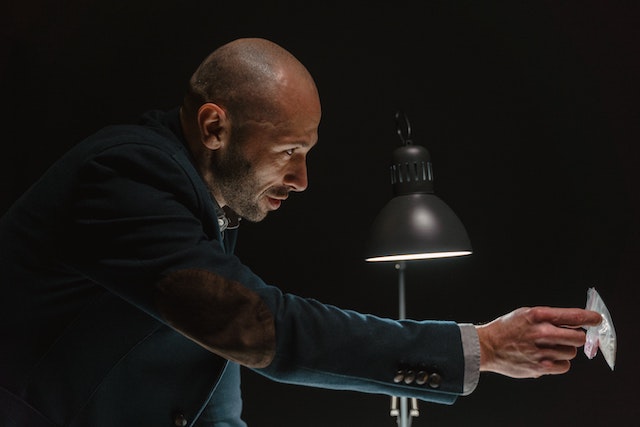2 Great Ways to Introduce Your Mystery’s Detective So Your Reader Cares

At the beginning of your mystery story, along with wanting your reader to wonder, What will happen next? you want to get your reader to care about your sleuth.
The emotional connection bonds your reader to your protagonist. That connection helps them follow your detective through all the trials and tribulations of trying to solve the mystery puzzle.
Getting your reader to care is the first step to take your reader on the journey of your story.
Before you get too far into the mystery of the crime, you want your reader to care about your detective. That doesn’t mean they need to like your character, they just need to care.
The Everyday Life
You may have read that you want to open your story with the protagonist’s everyday life. This can be misleading for new mystery writers.
You don’t need to show your detective waking up or describe what they have for breakfast or dinner. In fact, avoid those openings.
Get into the story. Show your detective detecting. Give your reader a taste of the skills your detective has that will help them ultimately solve the case.
Before we look at two great ways to introduce your detective, you’ll have a better idea if you understand the process at the story’s beginning.
The Set Up for the Main Event
The beginning of your story sets your reader’s expectations for the rest of the novel. You make a promise that if they continue reading they’ll not only have a mystery, but you show them the type of storytelling you do.
- setting – introduce the time and place of the story so your reader knows where they are
- protagonist – your detective. The character who serves as the reader’s guide to solving the puzzle
- tone – dark, light-hearted, witty, matter-of-fact, etc. Set the tone now so your reader understands this is the way the story will be told
- point of view – third person, first person, etc. Some readers have a preference
Setting up reader expectations helps your reader understand what type of mystery they’ll be reading. If they like your combination, they’ll keep reading.
If you stray from your original promise, like changing the tone, they may feel disappointed and leave a bad review. It’s better to deliver on your promise. That’s why the setup is so important.
If you want to change your storytelling style, save it for a different book.
Everything at the beginning gets your reader hooked on your mystery. Giving them a sense of your detective provides a key to how the mystery will be solved.
There are two main ways to introduce your detective and you may want to provide a bit of both.
Personality
Show your detective’s personality right at the start. Give them an opinion about something—another character, the town they’re in, how much they love their new EV. It doesn’t matter so much what the opinion is about, but that they have an opinion.
Readers understand opinions. They have them. They relate to your character’s opinion, even if they don’t agree with the opinion. Readers don’t want a namby-pamby character. They want a protagonist who knows what they want.
When your character interacts with others, their dialogue is a way to help your reader understand their personality.
Writer Joslyn Chase suggests different personality scales to use.
Team Player . . . . . . . . . . . . . . . . . . . . . . . . . . . . . Rebel
Introvert . . . . . . . . . . . . . . . . . . . . . . . . . . . . . . . . Extrovert
Go getter . . . . . . . . . . . . . . . . . . . . . . . . . . . . . . . . Laid back
Smart . . . . . . . . . . . . . . . . . . . . . . . . . . . . . . . . . . . Not so smart
Tough . . . . . . . . . . . . . . . . . . . . . . . . . . . . . . . . . . . Wimpy
Doer . . . . . . . . . . . . . . . . . . . . . . . . . . . . . . . . . . . . Dreamer
Believer . . . . . . . . . . . . . . . . . . . . . . . . . . . . . . . . . Doubter
Driven . . . . . . . . . . . . . . . . . . . . . . . . . . . . . . . . . . Lazy
Morally upright . . . . . . . . . . . . . . . . . . . . . . . . . . . Morally bankrupt
Know where to position your sleuth on each scale. You’ll have a multilayered personality. So besides an opinion, introduce another aspect of your sleuth’s personality to give your reader depth.
In the beginning—the setup—show your reader the spunky/intelligent/belligerent/mild-mannered/detail-oriented sleuth they’ll follow for the remainder of your story.
Skills
Whether your detective is a cake-making local or a hard-boiled professional, your reader wants a hint of the skills they will use to solve the mystery.
Before your detective takes on the puzzle of the story, show them displaying one of their skills which they’ll use later to solve the case.
Even if your sleuth is an amateur, they will have skills that make them the right person to solve a crime.
List curator Incubar lists professional skills for a law enforcement detective. You can tailor these skills to your fictional protagonist.
- A passion for the job
- Naturally sharp instinct
- Ability to read people
- Critical thinking/problem-solving skills
- Attention to detail
- Written and oral communication skills
- Computer skills
- Patience
- Quick recall
You can mix which skills you give your detective, but you want to show at least one in your opening sequence.
The Opening Sequence
Show your character in action. It’s the best way to introduce them. Your reader learns right away how they think and behave.
When your detective solves a problem, they interact with the people and the world around them naturally displaying their personality and skills they use everyday.
The opening sequence is how you introduce your protagonist to the reader and show them who they are. Don’t force them to meet the readers expectations.
Create the character who you want to show, and don’t force them to act like the ones you think would be liked. Your reader doesn’t need to like your character, they need to know how they solve problems. Because, the big problem of your mystery is solving the puzzle of who did it.
Ready to take your mystery to the next level? Write A Killer Mystery is a course that takes you through all the steps from story idea to The End.
Photo by MART PRODUCTION






